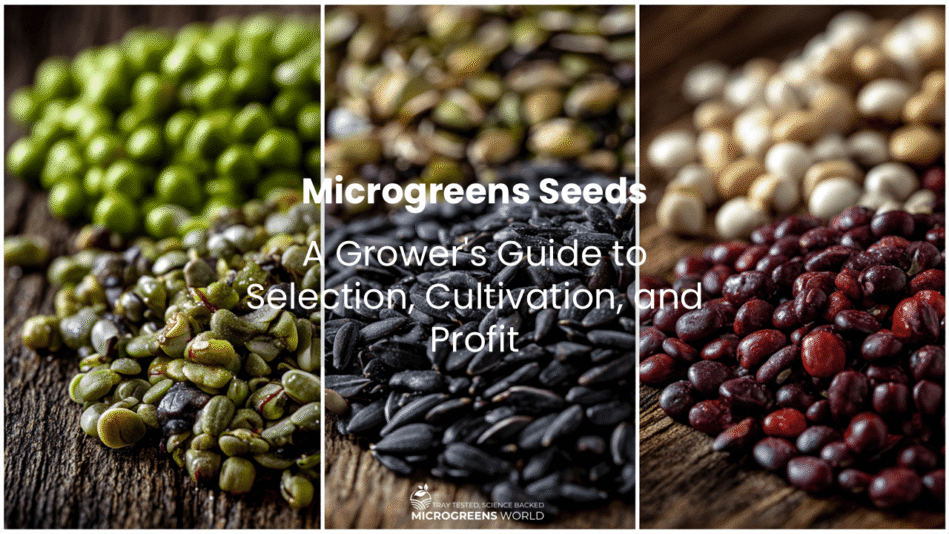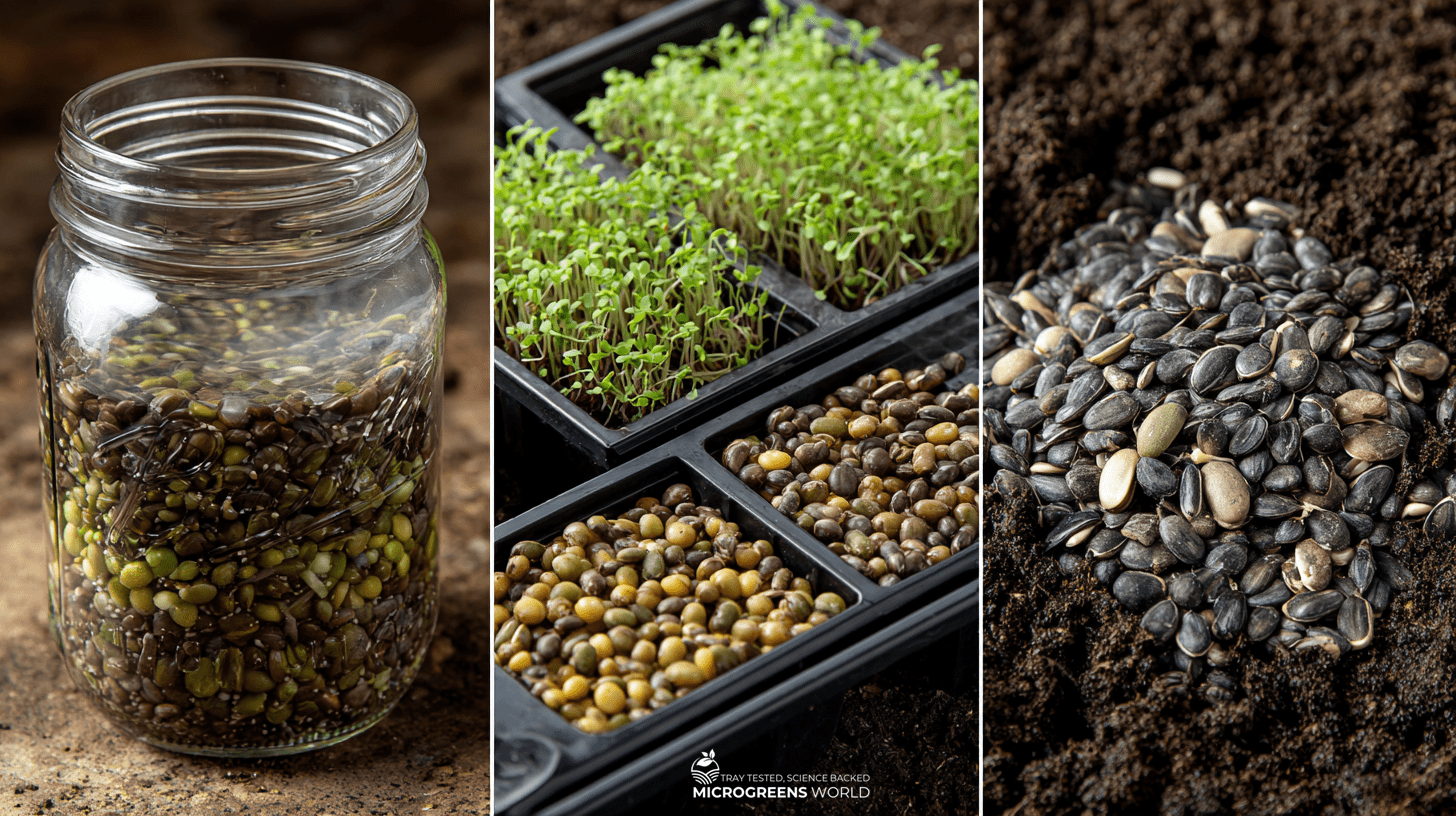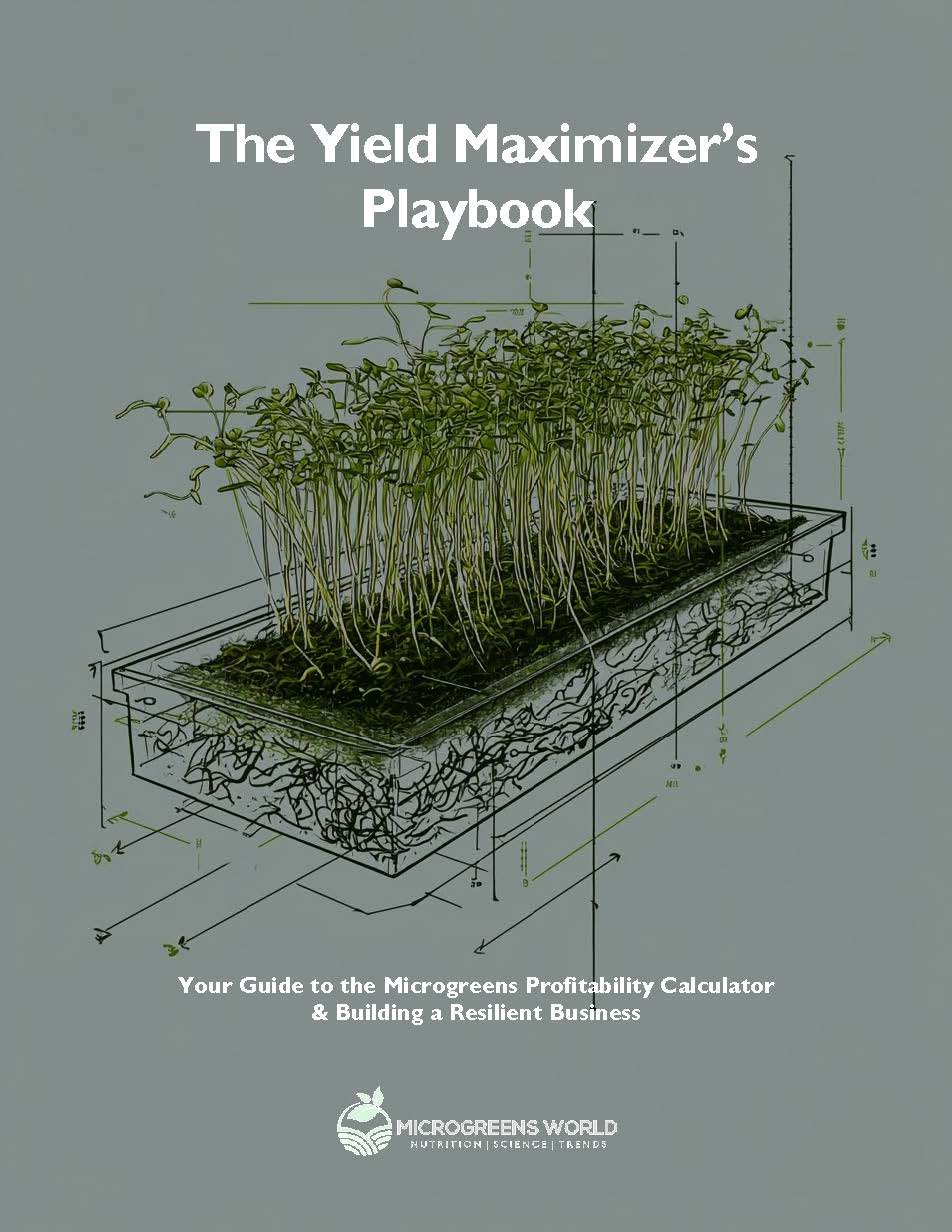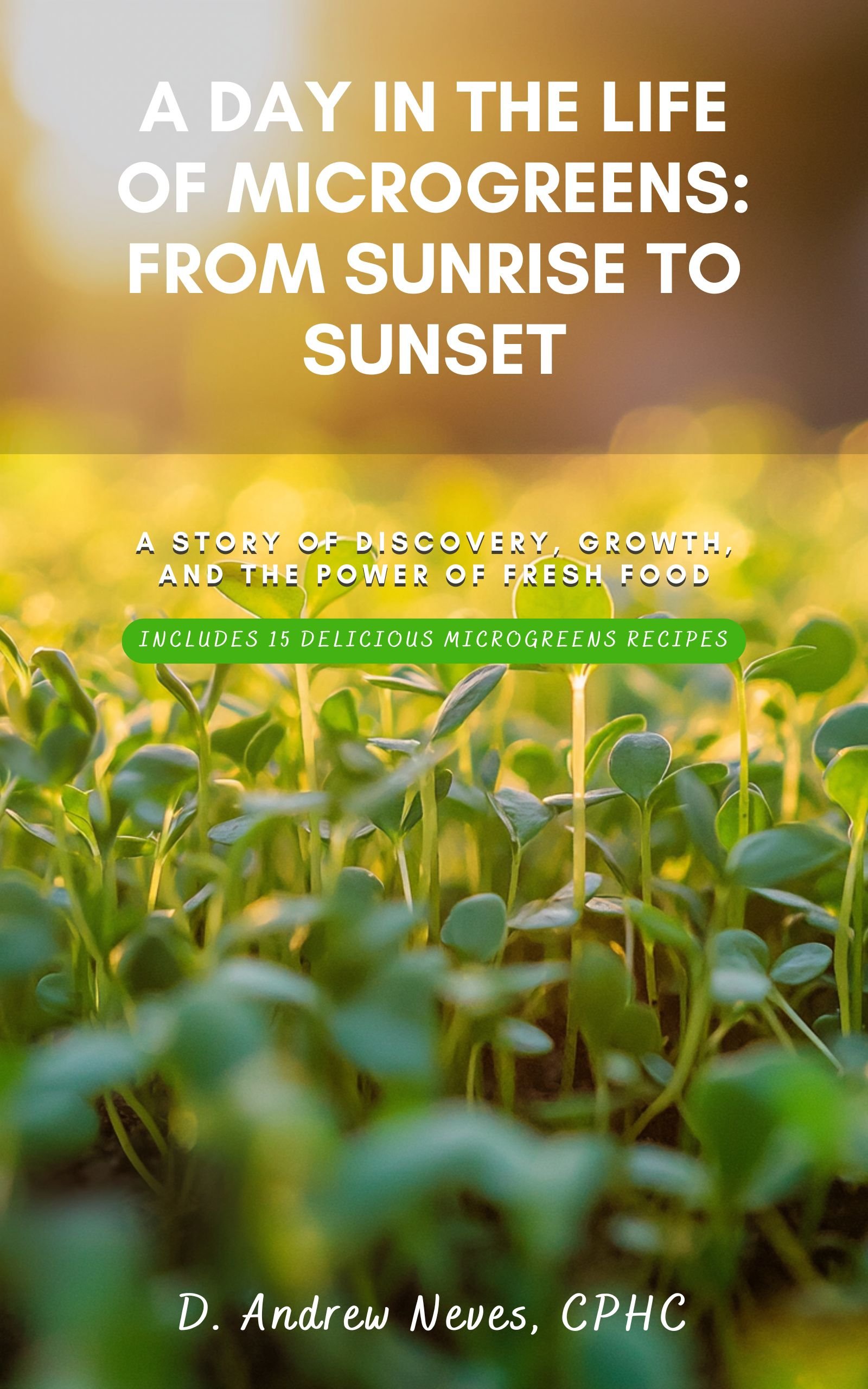You might say that the problems facing a new grower are like the weather: everybody talks about them, but few offer a concrete plan for success. This guide is that plan.
Select certified pathogen-free seeds with 90%+ germination from suppliers providing lab certificates and organic verification. Begin with radish (fastest), broccoli (sulforaphane-rich), and peas (high-yield). Bulk purchasing reduces costs while specialty varieties like Shiso command premium restaurant prices.
Whether you’re looking to grow a few trays for your family or supply local restaurants, success starts with understanding your seeds. By the end of this guide, you will know the difference between seed types, how to grow a perfect tray, how to troubleshoot common failures, and how to think about the numbers that drive a profitable microgreens business.
This is your single source for understanding microgreens seeds.
Key Takeaways
- Not all seeds are created equal. Microgreens seeds are tested explicitly for high germination rates and pathogen safety, unlike regular garden seeds that may contain fungicides unsafe for dense indoor growing.
- Start with the “Can’t-Fail” trio: radish (fastest results), broccoli (most forgiving), and peas (substantial harvest). This gives beginners the best chance of early success.
- Bottom-watering prevents mold. Always water from below using a two-tray system to keep leaves dry and avoid the most common growing failure.
- Bulk buying transforms profitability – A single ounce of broccoli seed costs $5.00 in packets versus $0.97 when bought in bulk, representing an 80% savings that directly benefits the profit.
- Match seeds to your market – Chefs pay premium prices for specialty varieties like Shiso, while market customers prefer reliable favorites like Sunflower and Kale.
Are You Ready to Start Your
Microgreens Business?
Take a 5-minute assessment and discover your strengths and gaps
before you invest
Part 1: The Foundation – Understanding Your Seed
What Exactly is a “Microgreen Seed”?
Microgreens vs. Sprouts vs. Garden Seeds: A Critical Distinction
Basic Seed Storage: Protecting Your Purchase
Part 2: The Grower’s Playbook – From Seed to Harvest
The Best Microgreens Seeds: Recommendations for Your Goal
How to Grow Microgreens: A Step-by-Step Guide
Troubleshooting: A Guide to Common Growing Problems
Part 3: The Business of Seeds – From Cost to Customer
The Economics of Your Seed Supply
What Exactly is a “Microgreen Seed”?
Let’s start with the most direct question. A microgreen seed, botanically speaking, is the same species as its full-grown vegetable or herb counterpart. A broccoli microgreen seed is still Brassica oleracea. The difference lies not in the genetics but in the sourcing, testing, and purpose.
A seed company that sells “microgreens seeds” is selecting varieties based on traits that matter in a tray, such as uniform growth and vibrant color. More importantly, they are testing these seeds for high germination rates and for pathogens, as they know you will be planting them densely indoors. They are the same seeds, but they have been carefully selected for a specific purpose.
Microgreens vs. Sprouts vs. Garden Seeds: A Critical Distinction
These terms are often used interchangeably, but for a grower, the difference is critical to both safety and success (FoodSmart).
| Seed Type | Growing Method | Part Eaten | Key Characteristic |
| Sprouts | In water, with frequent rinsing | Entire seed, stem, and root | Requires seeds to be tested for high-risk pathogens, such as E. coli, as the entire product is consumed raw. |
| Microgreens | In a growing medium (soil/coir) | Stem and leaves only | Requires seeds with a high germination rate for a dense canopy. The roots and seed hull are left behind. |
| Garden Seeds | In outdoor soil, spaced far apart | The final, mature plant | Often treated with fungicides to prevent disease in a field setting, making them unsuitable for dense planting. |
A Word on “Organic Seeds”
Is the extra cost for certified organic seeds justified? It depends entirely on your goal.
For the commercial grower, the “USDA Organic” seal is a powerful marketing tool that allows you to charge a premium. For you, the extra cost is a business expense that should be offset by higher prices.
For the home grower, the benefit is less clear. Most seeds from reputable suppliers are already non-GMO. If growing organically is essential for your own peace of mind, then it is a worthwhile expense. However, if your goal is simply to obtain nutritious food, high-quality non-organic seeds will produce an equally healthy crop.
Basic Seed Storage: Protecting Your Purchase
You have just invested in high-quality seeds. Do not let that investment go to waste. The three enemies of a seed’s viability are heat, light, and moisture. Your storage solution should be simple: keep them in a cool, dark, and dry place. An airtight container, such as a glass jar, in a pantry closet is perfect.
The Best Microgreens Seeds: Recommendations for Your Goal
The question I hear most often is, “What are the best seeds to grow?” The only honest answer is that it depends on your goal.
For the Home Grower: Success is the best teacher. Your goal is to get a fast, beautiful, and tasty result. I recommend starting with the “Can’t-Fail” Trio: Radish (for speed), Broccoli (for nutrition), and Peas (for a substantial, crunchy harvest).
For the Commercial Grower: Your “best” seeds are the ones that drive profit. This is a function of customer demand, speed, and yield. Start with Sunflower (a chef favorite), Radish (a fast, reliable workhorse), and Kale (trusted by health-conscious customers).
How to Grow Microgreens: A Step-by-Step Guide
This is the fundamental process. The professional method uses two 10″x20″ trays: a top tray with drainage holes for your plants, and a solid bottom tray to hold the water.
- Step 1: Soaking (For Large Seeds Only): This step is only necessary for seeds such as peas and Sunflowers. Submerge them in cool water for 6 to 12 hours.
- Step 2: Preparing Your Tray and Medium: Fill your top tray (the one with holes) with about an inch of coco coir. Moisten it until it’s damp like a wrung-out sponge, but not waterlogged.
- Step 3: Sowing the Seeds: You want an even, consistent carpet of seeds. Hold your hand high and sprinkle them evenly, much like a chef salting a dish from above. This prevents clumping.
- Step 4: The Blackout and Germination Period: Mist the seeds one last time, then cover the tray with a blackout dome or another inverted tray to maintain darkness. You can stack trays and add a bit of weight (like a paver brick, but ensure it’s clean and your shelving can support it) to encourage strong root growth. Leave them in total darkness for 3 to 4 days.
- Step 5: Introducing Light and Water: Around day 4, you should see a mat of pale, yellowish shoots. It’s time for light. From this point on, bottom-water only. Pour about a cup of water into the solid-bottom tray and place the growing tray inside. The medium will soak up the water through the drainage holes. This keeps the delicate leaves dry and is the most critical thing you can do to prevent mold (Penn State Extension).
Troubleshooting: A Guide to Common Growing Problems
Even with the best plan, you will run into issues. Here’s how to diagnose and solve the most common ones.
| Problem | Diagnosis & Solution |
| White “Fuzz” on Your Soil | Is it mold or root hairs? Root hairs are bright white, uniform, and look like a fuzzy halo around each root; they vanish when misted. Mold is patchy, web-like, and may have a musty smell. Solution: If it’s root hairs, do nothing! They are a sign of healthy growth. If it’s mold, increase airflow immediately with a small fan and check if your seed density was too high. |
| Poor or Patchy Germination | The cause is likely one of three things: poor seed quality, improper watering (either too wet or too dry), or seeds clumping together. Solution: Ensure your medium is consistently moist during germination. If the problem persists, try a new batch of seeds from a reputable supplier. |
| “Leggy” or Weak Stems | The cause is almost always insufficient light. The plants are desperately stretching for a light source that is too far away or not intense enough. Solution: Move your light source closer to the plant canopy. For LEDs, this can be as close as 6 to 8 inches. |
| Yellowing Leaves | This is normal right after the blackout period. If the seeds stay yellow after 24-48 hours of light, they aren’t getting enough energy to produce chlorophyll. Solution: Check your light source. Ensure it’s close enough and running for at least 12 hours a day. |
Now that you know how to grow a perfect tray and troubleshoot common issues, let’s look at the economics that make this a worthwhile endeavor.
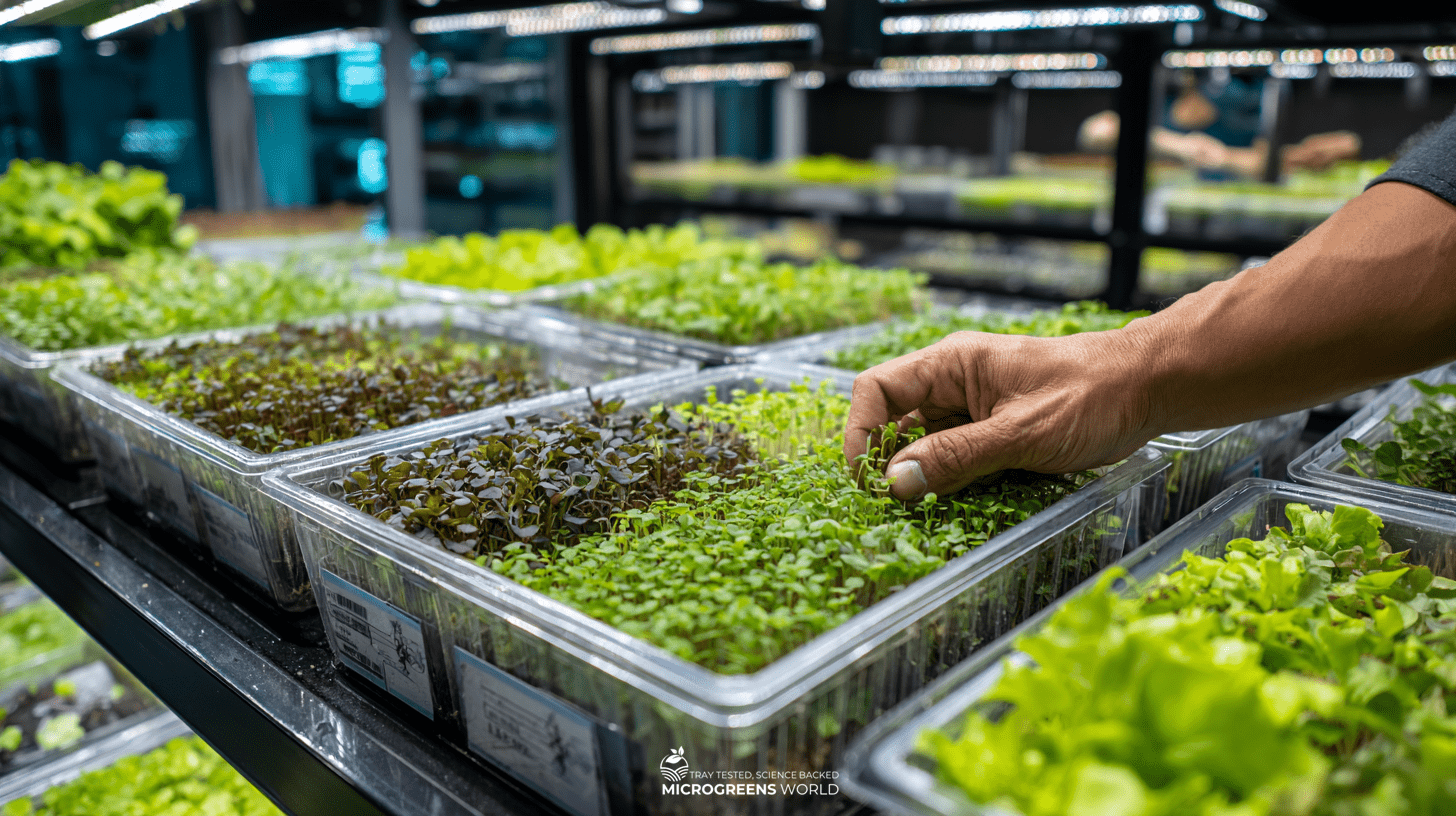
The Economics of Your Seed Supply
Let me give you an example: the math of your seed supply is the first and most crucial step in building a profitable farm.
Sourcing Seeds: What Professionals Look For When choosing a supplier, you are choosing a business partner. Look for guarantees of high germination rates, pathogen testing data, and lot numbers on the packaging for traceability.
The Math of Bulk vs. Packet Seeds. Let’s say you need one ounce of broccoli seed.
- The Packet: A one-ounce packet at a garden store might cost $5.00.
- The Bulk Bag: A one-pound bag from a supplier like True Leaf Market might cost $15.54. Since there are 16 ounces in a pound, the cost of a single ounce is now just $0.97. That is a savings of over 80%. What you see is a concrete scheme for action—that $4.03 in savings flows directly to your net profit.
Bulk Seed Storage & Viability: Managing Your Inventory. Of course, these savings are only realized if you can store your bulk seed adequately. For a commercial grower, this means using airtight, food-grade containers and implementing a “First-In, First-Out” (FIFO) system, where the oldest stock is used first. Most Brassica seeds (such as broccoli and kale) will last 1-2 years under ideal conditions. Larger seeds, such as peas and sunflowers, can last even longer, from 2 to 4 years.
Strategies for Your Specific Business
For chefs and restaurant suppliers: Chefs want novelty and intense flavor. Your business with them is about providing a unique, high-quality ingredient. This is where specialty seeds like Basil, Shiso, and Sorrel shine. A chef’s profit calculation on high-cost, high-margin Shiso is very different from a market grower’s calculation on high-volume, lower-margin radish. The calculator can help you model both.
For Retailers and Market Growers: Your customers are seeking value, nutrition, and visual appeal. Focus on customer favorites, such as sunflower, kale, and colorful radish varieties. Offering a “Spicy Salad Mix” is an excellent strategy for new customers.
The Science of Nutrition: Backing Up Your Claims. Instead of general “superfood” statements, use specifics. For example, broccoli microgreens are one of the most extensively studied functional foods due to their high concentration of sulforaphane. This compound has been the subject of significant research (Fahey et al., 1997). Likewise, studies have shown that microgreens, such as red cabbage, cilantro, and radish, contain noteworthy concentrations of essential vitamins and carotenoids (Xiao et al., 2012). Citing your sources builds trust and authority.
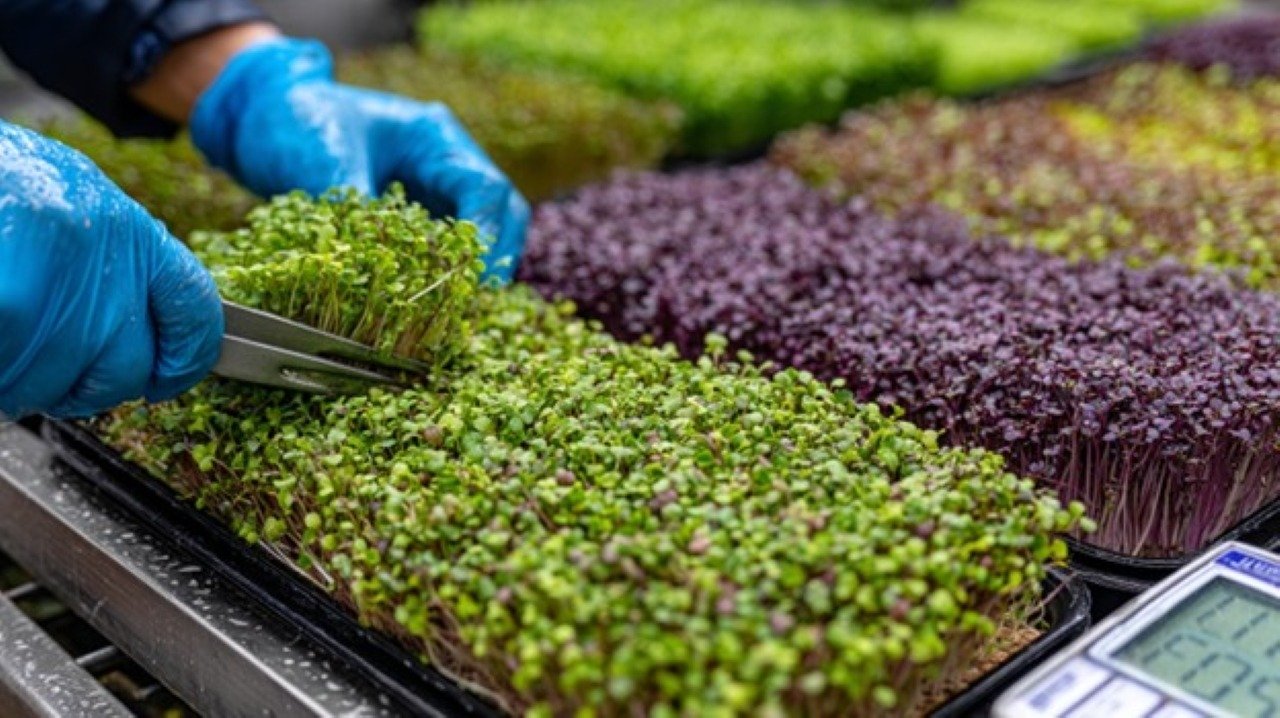
You began this guide with a simple but powerful goal: to move from guessing to knowing.
We have covered a great deal of ground together. We started with the foundation, learning the critical difference between a microgreen seed, a sprout, and a garden seed. We walked through the step-by-step process of growing a perfect tray, and, just as importantly, we created a plan for troubleshooting the inevitable failures that occur along the way.
From there, we put on the hat of a business owner. We examined the complex numbers behind sourcing seeds, managing inventory, and developing a strategy to serve a specific customer, whether that’s a local chef or a family at the farmers’ market.
What you see now is a concrete scheme for action. This plan connects a single seed to a thriving plant and connects that plant to a resilient, profitable business. You understand that your success is a function of both excellent growing techniques and a solid understanding of your own numbers.
The path forward is one of continuous improvement and observation. Use the calculator to test your ideas before you risk your time and money. Utilize the techniques outlined in this playbook to increase your yields. Track your results, communicate with your customers, and continue learning.
You now have the playbook. The only question left is, what will you grow next?
Related Questions
Microgreens seeds are seeds of vegetables and herbs that are specifically sourced and tested for growing densely in trays. They typically have high germination rates and are untreated with fungicides.
How are microgreens different from sprouts?
The primary difference is the growing method. Sprouts are germinated in water, and the entire seed and root are eaten. Microgreens are grown in soil or another medium and are harvested by cutting the stem above the soil line.
What are the easiest microgreens seeds for a complete beginner to grow?
For beginners, success is about speed and reliability. The best seeds to start with are Radish (very fast), Broccoli (very forgiving), and Peas (large seeds that produce a substantial crop).
Can I use regular garden seeds for microgreens?
It is not recommended. Many garden seeds are treated with chemical fungicides that are not safe for consumption at the dense seeding rates used for microgreens.
Where is the best place to buy microgreens seeds?
For serious growers, the best option is a reputable online bulk supplier, such as True Leaf Market. The cost per tray is significantly lower than buying small retail packets.
Are You Ready to Start Your
Microgreens Business?
Take a 5-minute assessment and discover your strengths and gaps
before you invest
Fahey, Jed W., et al. “Broccoli Sprouts: An Exceptionally Rich Source of Inducers of Enzymes that Protect Against Chemical Carcinogens.” Proceedings of the National Academy of Sciences of the United States of America, vol. 94, no. 19, 1997, pp. 10367–72. PubMed Central, doi:10.1073/pnas.94.19.10367.
“Growing Microgreens.” Penn State Extension, 30 Jan. 2023, extension.psu.edu/growing-microgreens.
“Microgreens.” FoodSmart, Colorado State University Extension, 2022, foodsmart.colostate.edu/microgreens/.
“Safe Production of Sprouts & Microgreens.” Institute for Food Safety at Cornell University, 2023, foodsafety.cornell.edu/guidance-and-resources/safe-production-sprouts-microgreens/.
“Seeds for Microgreens.” True Leaf Market, 2024, trueleafmarket.com/collections/micro-greens-planting-seed.
Xiao, Zhenlei, et al. “Assessment of Vitamin and Carotenoid Concentrations of Emerging Food Products: Edible Microgreens.” Journal of Agricultural and Food Chemistry, vol. 60, no. 31, 2012, pp. 7644–51. ACS Publications, doi:10.1021/jf300459b.
